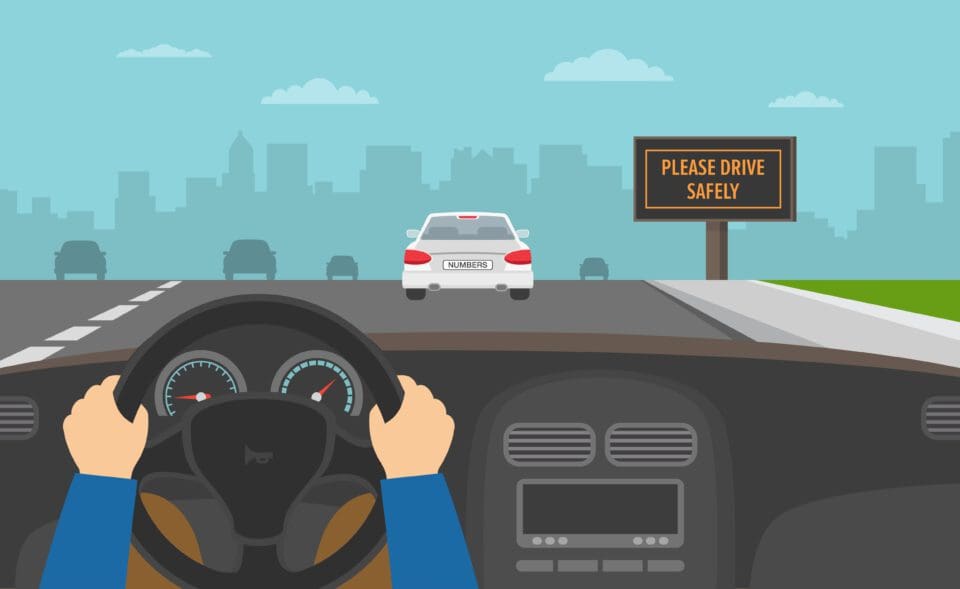How Do Vision & Vision Loss Impact Driving?
Home / Vision Education Center /
Last Updated:
How do you get to work each day? Most of us slip behind the wheel of a car. In fact, according to Gallup, 83 percent of American adults drive several times each week, and 64 percent of us drive every day.
Table of Contents
You need agility and flexibility to drive a car, but you also need crisp vision. Age-related eye changes and some types of ocular disease can make seeing the road difficult.
When that happens, you might feel nervous or worried about driving, and you might start to make subtle mistakes when you slip behind the wheel.
If you’ve been driving for decades, it’s tough to think about giving up your keys. In some states, the decision to keep driving will not be yours to make. You will need to pass a vision exam periodically, and if you can’t, you will not have a license.
If that has not happened yet but you are not sure if it’s time, a close friend can ride with you and give you advice.
If you must stop driving, you are not stuck at home. You can hop on a bus, hail a ride through your phone, or try walking or riding your bike.
Vision Changes That Impair Safe Driving

As our eyes age, they stiffen and clear surfaces cloud. These changes are natural, but they can make routine driving activities tough. The American Optometric Association says people 60 and older can struggle with:
- Road signs. The shape and color of signs can grow indistinct, and that could leave you feeling unsure of what’s permitted.
- Instrument panels. If close vision is an issue for you, it could be hard for you to gauge your speed.
- Glare. Oncoming headlights can seem brighter than they did before, and in some cases, the light can leave you dazzled and unable to see anything at all.
- Peripheral vision. You might need to turn your head to see objects coming at you from the side.
- Color. Is the traffic light red or green? Changes in color perception could make answering that question very difficult.
Age-related changes are not the only things that can detract from safe driving. Some eye diseases can impair your vision, and they can strike people of almost any age.
The American Academy of Ophthalmology says driving can be tough for people with:
- Cataracts. This clouding of the lens in the front of the eye can amplify the brightness of headlights and streetlights. They can also leech the color out of signs and traffic signals.
- Macular degeneration. This disease causes gaps in the center of your visual field. You might be able to see items coming your direction from the sides, but the area right in front of your car might be lost to your sight.
- Retinopathy. This diabetes complication damages the retina, and that can lead to a loss of both central and peripheral vision.
- Glaucoma. Blind spots in central or peripheral vision appear as this disease damages the optic nerve.
Even seemingly minor eye health problems can make crisp vision difficult. Chronic dry eye, for example, can impair your ability to see clearly at night.
Driving Changes You Might Notice

Some eye health conditions, like glaucoma and retinopathy, cause such big problems that you know driving just is not safe. But others cause subtle shifts, and that can leave you wondering if you should stop driving or wait for things to worsen.
There are some vision signs, according to the American Academy of Ophthalmology, that are too serious to ignore. They include:
You deserve clear vision. We can help.
With 135+ locations and over 2.5 million procedures performed, our board-certified eye surgeons deliver results you can trust.
Your journey to better vision starts here.
- Blurred vision.
- Intolerance of glare from headlights.
- Dark spots obscuring your vision.
- Inability to see things like pedestrians or difficulty reading road signs.
Try driving an unfamiliar route at dawn or dusk, and be honest about how well you can see during the trip. You might find that your “good” skills were based on muscle memory and luck.
AARP suggests that these signs could also indicate unsafe driving, and some of these attributes have little to do with vision:
- Decreased confidence in your driving skills
- Weaving into and out of your driving lane
- Hitting the curb when you are making a right turn
- Frequent car dings and scratches
- Many close calls
If you can’t see well, it’s hard to navigate your car safely from one place to another. It’s best to stop driving before a close call becomes a serious accident.
Can You Drive After an Eye Surgery?
The amount of time you need to wait before you can drive following eye surgery depends on a number of factors, including the type of surgery you had. Barring complications, recovery times from most eye surgeries is often fast, and generally you can drive as soon as 24 hours after the procedure.
For more complicated eye surgeries, recovery may take longer. No matter the procedure, eye specialists recommend not driving a vehicle within the first full day after surgery.
Your vision may be clear immediately after surgery, but some blurring can occur some hours post-surgery. Also, during your procedure, anesthetic eye drops are used and your eyes will likely be irritated and sensitive to light as they wear off. This can lead to eye-watering which may affect your vision considerably.
You are required to attend a post-care appointment the following day after eye surgery. Your eye doctor will determine whether you are fit to drive. For most patients, you will be able to drive after the initial follow-up appointment. However, most doctors will recommend waiting a further few days until you are completely comfortable and your eyesight is stable before you can resume driving.
However, every patient is different. Not even your doctor can predict before eye surgery the exact amount of time it will take before you can after his work is done.
Dangers of Driving at Night
According to Sue Lowe, chair of the Health Promotions Committee in the American Optometric Association, among the top complaints from patients at their offices is difficulty driving at night. Patients with cataracts and glaucoma are particularly sensitive to glares from the headlights of oncoming vehicles.
Peripheral vision, depth perception and color recognition may be compromised in the dark. For older drivers, compromised night vision is another problem.
The AOA believes driving becomes more difficult after the age of 60. Fatigue from long work hours and lack of quality sleep is more likely to kick in at night.
A temporary side effect of eye surgery is some difficulty in driving at night. When you drive at night following eye surgery, you may experience glares from bright headlights among other issues such as halos.
Driving experts also advise to refrain from night driving while these symptoms persist. Depending on the severity of the symptoms, it can take a week or more before you can drive at night safely.
You deserve clear vision. We can help.
With 135+ locations and over 2.5 million procedures performed, our board-certified eye surgeons deliver results you can trust.
Your journey to better vision starts here.
Should You Stop Driving?

Often, drivers know when it’s time to give up their keys. You might have shifted your driving behaviors as your vision changed so you could stay a little safer on the road. But if you are really not sure, your friends and your state can give guidance.
Research cited by Prevent Blindness suggests that people with low vision make adjustments, such as:
- Driving only short distances.
- Limiting trips to one hour or less.
- Sticking to familiar locations.
- Avoiding night driving.
Steps like this can help you stay a bit safer, but there may come a day when it’s just not reasonable for you to continue with your driving habit. You may find that out when it’s time to renew your license.
In most states, you will need to pass a visual acuity exam before you can renew your license. This exam works much like the vision test you take at the doctor’s office. You will stand far from a board marked with letters, and you will call out the ones you can read.
In some states, older drivers are required to take these tests every five years or less. In others, someone who sees you driving in an unsafe manner can ask for additional testing.
You can ask for input, so people can help you without getting officials involved.
Ask someone you trust to go on car trips with you and point out any risks you’re taking. Your passenger might tell you about:
- Lane changes.
- Pedestrians waiting to cross the street.
- Squirrels running into the road.
- Stop signs you’ve ignored.
- Slow reactions to hazards.
This is hard feedback to digest, but it can help you see all the dangers you’ve been overlooking. At the end of a trip like this, you might be convinced that your best driving days are behind you.

Life Without a Driver’s License
Just because you can’t drive does not mean you can’t leave your house. In fact, it’s easier now than ever to get from place to place without a car.
Your options include:
- Public transportation. Buses, trams, and light-rail systems can get you from place to place at a low cost with no driving involved. In some cities, you can get a discount on a transportation pass with proof of a vision-related disability.
- Ridesharing. Companies like Uber and Lyft let you hail a car from your phone, and you do not need cash to pay your driver.
- Cycling. Some cities make bike riding both safe and easy. Cyclists move at a slower speed than drivers do, and that could help you accommodate some vision problems.
- Walking. It’s healthy for your body to walk a bit each day, and you might enjoy the stroll too. If your vision is quite poor, you will need sturdy shoes and a walking stick to make the trip safely.
- Senior services. Some communities offer services for seniors, so you can go to doctors’ appointments in a vehicle at no cost. Your doctor can tell you more about these opportunities.
Your friends and family members might also be willing to help you with transportation.
None of these options are as convenient as hopping into a car and stepping on the gas pedal. But all of them are reasonable for people who struggle with vision.
Using them helps you keep yourself and your entire community safe. That is worth a bit of extra work.
You deserve clear vision. We can help.
With 135+ locations and over 2.5 million procedures performed, our board-certified eye surgeons deliver results you can trust.
Your journey to better vision starts here.
References
- 83 Percent of U.S. Adults Drive Frequently; Fewer Enjoy It a Lot. (July 2018). Gallup.
- Adult Vision: Over 60 Years of Age. American Optometric Association.
- Vision and Driving. (November 2018). American Academy of Ophthalmology.
- We Need to Talk: The Difficult Driving Conversation. AARP.
- Low-Vision Seniors Are Self-Limiting Driving. (December 2016). Prevent Blindness.
- What Is the Average Age Seniors Stop Driving? Factors in Determining Older Driver Safety. (December 2017). Institute on Aging.
- State by State Look at Driving Rules for Older Drivers. (September 2012). Claims Journal.
- How Soon Can I Drive after Eye Surgery. (April 2019). Better Vision Guide.
- Driving After Cataract Surgery. (November 2020). Eye Surgeons of Indiana, Surgical Care Center.
- Help Patients See the Light When Driving at Night. (October 2018). American Optometric Association.
- The Most Dangerous Time to Drive. National Safety Council.
- Senior Vision. (American Optometric Association).
This content is for informational purposes only. It may have been reviewed by a licensed physician, but is not intended to serve as a substitute for professional medical advice. Always consult your healthcare provider with any health concerns. For more, read our Privacy Policy and Editorial Policy.
